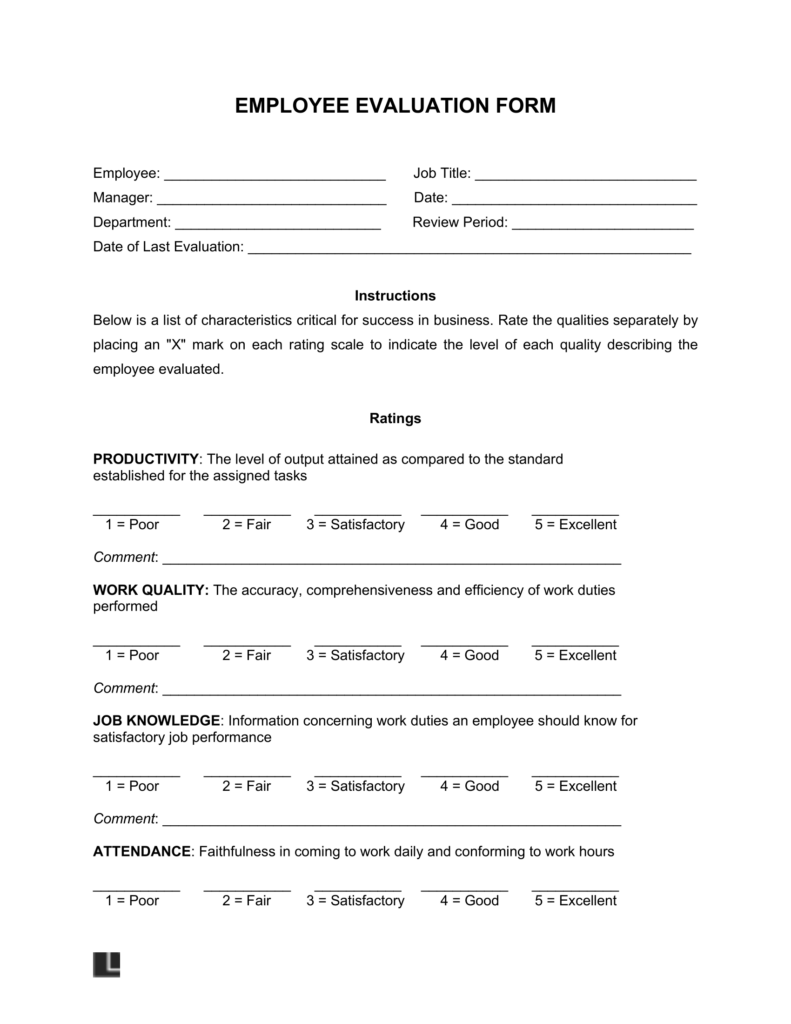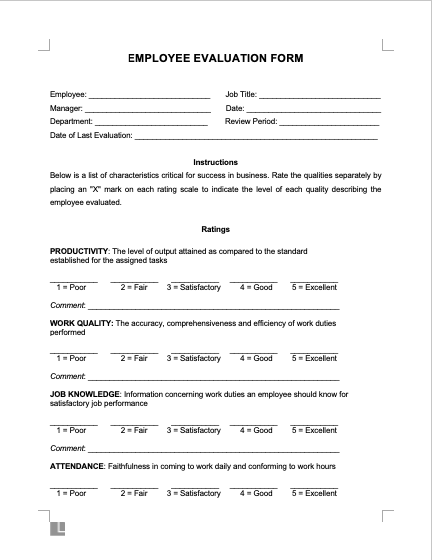An employee evaluation (performance review) will help you assess employees consistently and fairly. Employee review is a valuable part of a business. It ensures that workers are held to high standards and given the information needed to improve their job.
Many companies conduct performance evaluations annually or twice a year.
The content of an employee evaluation can change to meet your unique needs. An employee performance review template allows you to create a printable form you can use with your business.
What is an Employee Evaluation Template?
An employee evaluation template is a document that assesses an employee’s job performance and provides feedback. It typically includes questions or a set of criteria used to evaluate specific aspects of the employee’s job, such as their technical skills, teamwork, communication, and overall job performance.
The results of the evaluation are used to determine areas of strength and weakness, set performance goals, and provide feedback to the employee on their work.
These documents are a valuable indicator of the success of a company and its management of employees. It gives you the critical information to handle human resources and make informed business decisions.
Employee Performance Evaluation Methods
There are several different methods to evaluate employee performance; some of the most popular include:
Self-Assessment
You might be interested in employee evaluation using self-assessment questions. Self-awareness is essential; you might be interested in how your employees feel their performances have gone.
You can even use self-assessment questions with employee evaluation comments the manager leaves. Consider including self-assessment questions as a part of the employee evaluation process.
Team Assessment
If you want your business to be successful, you need your employees to work together as a strong team. A team assessment could be helpful. That way, you will have an easier time figuring out which team members are working well together and what might have to be adjusted.
360-Degree Rating
This evaluation allows employees to receive confidential, anonymous feedback from everyone they work with. For example, this process might incorporate feedback from their managers, peers, and people who report directly.
Anyone who the employee interacts with daily may contribute to this evaluation.
Peer Review
A peer review process is also essential. This is an evaluation that your employees can use to evaluate their colleagues. In some cases, these evaluations are anonymous, which makes it easier for employees to be honest about how they feel they are getting along with their colleagues.
Introductory Period Performance Review
An introductory performance review is typically done after employee onboarding has been completed. This process makes it easier to determine whether employees fit their hired role well.
This may also allow the employee to evaluate their training.
30-60-90 Review
It is helpful to receive feedback from many people to help employees do their best. A 30-60-90 review combines input from coworkers and managers that will discuss leadership skills, personality, and character.
This process can make it easier for employees to figure out how to contribute positively to their work environment.
Main Formats
In general, there are two separate forms in which employees can receive feedback. Including a mixture of each form on a single template is also possible. These formats include:
Scorecard
The first format is called a scorecard format. It provides an objective rubric that rates employees in specific areas. It may use a scale of 1 to 5 or 1 to 10. Then, the person evaluating the employee will have to rate that particular skill on this scale. Or, the scorecard may include ratings for “exceptional,” “satisfactory,” “unsatisfactory,” or something similar.
The main advantage of a scorecard is that it is easier to fill out, but it may also limit the ability of the evaluator to share all of their thoughts.
Narrative
The other option is called a narrative format. In this format, the person evaluating the employee must answer several questions targeting specific areas. As the name suggests, the evaluator has a lot of freedom to include whatever they think is essential.
The main advantage of this format is that the evaluator is free to say what they want, but it may also take longer to fill out.
How to Write an Employee Evaluation
The entire purpose of an employee evaluation is to give the employee actionable tips that they can use to get better at their job and provide better performance for the company.
Some of the essential tips to keep in mind when writing an employee evaluation include the following:
Review the Employee’s Job Description
Before writing an employee evaluation, look at that employee’s job description. You must ensure your feedback is directly related to the employee’s job duties. For example, if you provide an evaluation of employee actions that do not relate directly to their job description, the feedback might not be helpful. Make sure the evaluation matches the employee’s job description.
Review Past Performance Review Data
Examine past performance reviews or evaluations to track the employee’s progress. Identify areas where improvements were recommended in previous evaluations and assess whether progress has been made.
Highlight Areas of Improvement
Begin the evaluation by acknowledging areas where the employee has excelled and performed well. This helps create a positive and supportive atmosphere.
Compare Strengths and Weaknesses
Compare the employee’s strengths and weaknesses. Be specific about their achievements and areas that need improvement. Use concrete examples and data whenever possible to support your assessment.
Recommend Actionable Goals
Make sure you always provide actionable feedback. At the end of the evaluation, the employee should know how to improve their job. These goals should be SMART (Specific, Measurable, Achievable, Relevant, Time-bound) and provide a clear path for development.
You may even want to provide the employee with goals to shoot for between this evaluation and the next one. If you give the employee something to aim for, you may provide them with additional motivation.
Provide Constructive Feedback Objectively
Offer constructive feedback on areas where improvement is needed. Be specific and objective, and avoid making it personal. Focus on behaviors and outcomes rather than making judgments about the person.
Welcome Employee Input
Encourage a two-way conversation by welcoming the employee’s input and perspective. Ask for their self-assessment and thoughts on their performance. This helps in fostering open communication and understanding.
What to Include in an Employee Evaluation Form
An employee evaluation form pdf may include many of the following sections.
- Employee Information: Employee name, ID, department, and position.
- Evaluation Period: Specify the time frame being evaluated.
- Performance Criteria: Clearly defined criteria or competencies relevant to the job.
- Rating Scale: A scale for rating performance (e.g., 1 to 5).
- Comments/Feedback: Space for written comments and feedback on each performance criterion.
- Self-Assessment: A section for the employee’s self-assessment, if applicable.
- Goals and Development: Space for setting and discussing performance goals and development plans.
- Overall Performance Rating: A summary or overall rating of the employee’s performance.
- Signature and Date: Signatures of both the evaluator and the employee, along with the date of the evaluation.
- Follow-Up Actions: Recommendations for improvement and follow-up actions, if necessary.
Employee Evaluation Form Sample
A standard employment evaluation form template provides necessary information you can edit to fit your particular needs. You can download this free employee performance review template in Word or PDF format.

Legal Considerations
Several critical legal considerations must be considered when filling out an employee evaluation. They include:
- Evidence: If the employee or company ever goes to court, reviews can be used as evidence. Evaluators need to keep this in mind when filling out an employee evaluation.
- Discrimination claims: If a discrimination claim is brought against the company, evidence from the evaluation can be used to support or refute the claim. Furthermore, companies should refrain from using two different templates for two other groups of people unless they fill different job roles.
- Retaliation: Retaliation is a significant problem in some Industries. The information included in an employee evaluation could be used as evidence to support or refute a retaliation claim. Unfairly downgrading the performance of an employee could be seen as retaliation.
Companies, employees, and managers who keep these points in mind should be able to provide a practical employee evaluation without exposing themselves to legal concerns.
Frequently Asked Questions
Why should I use an employee evaluation form?
There are many reasons you should utilize performance reviews with your business:
- Provide employers with measurable employee data they can use to improve their bottom line.
- Enable to know how the employees have performed to predict their ability to do a new job.
- Identify an employee’s strengths and weaknesses, which can help you determine what training or development opportunities are required.
- Provide a unique opportunity for managers and employers to communicate more clearly, and on a more open level.
- Provide a framework for setting and tracking performance goals.
- Encourage employees to take ownership of their careers and strive for continued growth and development.
Do employee performance evaluation forms make sense for small businesses?
Yes, employee performance evaluation forms make sense for small businesses as they allow you to review employee performance regularly.
Regular evaluations for employees in a business of any size can promote increased employee performance, help make promotion decisions, and bring to light any evidence of negative employee performance.
How do you prepare employee performance reports?
To prepare employee performance reports, you should:
- Keep up-to-date documentation of each employee and their feedback and performance during the year
- Allow the employee to perform a self-assessment
- Communicate with HR to get updates on any incidents
- Review the employee’s file before the appraisal
- After the appraisal, create a report from reviewing all documents and employee evaluation forms
Are there any legal issues to consider with evaluation forms for employees?
There are no specific legal issues to consider with employee evaluation forms, but you should not discriminate against any employee in any way and should be consistent with all employees.
What is the purpose of an employee evaluation?
The purpose of an employee evaluation is to review employees’ performance and create clear documentation that formally identifies areas the employee could improve.
They can also affect the future of the employee’s career.
